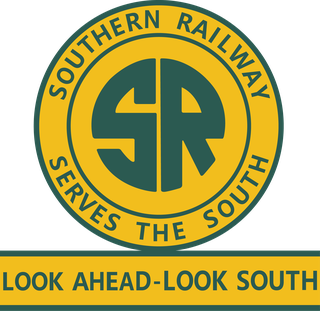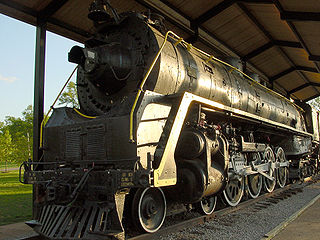
Walker County is a county located in the northwestern part of the U.S. state of Georgia. As of the 2010 census, the population was 68,756. The county seat is LaFayette. The county was created on December 18, 1833, from land formerly belonging to the Cherokee Indian Nation.

The Southern Railway is a name of a class 1 railroad that was based in the Southern United States. The railroad is the product of nearly 150 predecessor lines that were combined, reorganized and recombined beginning in the 1830s, formally becoming the Southern Railway in 1894.

The Nashville, Chattanooga and St. Louis Railway was a railway company operating in the southern United States in Kentucky, Tennessee, Alabama and Georgia. It began as the Nashville and Chattanooga Railroad, chartered in Nashville in December 11, 1845, built to 5 ft gauge and was the first railway to operate in the state of Tennessee. By the turn of the twentieth century, the NC&StL grew into one of the most important railway systems in the southern United States.
The Tennessee Central Railway was founded in 1884 as the Nashville and Knoxville Railroad by Alexander S. Crawford. It was an attempt to open up a rail route from the coal and minerals of East Tennessee to the markets of the midstate, a service which many businessmen felt was not being adequately provided by the existing railroad companies. They also wanted to ship coal and iron ore to the Northeastern US over the Cincinnati Southern Railway, which was leased to the Southern and operated as the Cincinnati, New Orleans and Texas Pacific Railway [CNOTP], through their Cincinnati gateway. The N&K was only completed between Lebanon, where it connected to a Nashville, Chattanooga and St. Louis Railway branch from Nashville, and Standing Stone.

The Louisville and Nashville Railroad, commonly called the L&N, was a Class I railroad that operated freight and passenger services in the southeast United States.

The Tennessee Valley Railroad Museum is a railroad museum in Chattanooga, Tennessee.

The St. Louis–San Francisco Railway, also known as the Frisco, was a railroad that operated in the Midwest and South Central U.S. from 1876 to April 17, 1980. At the end of 1970 it operated 4,547 miles (7,318 km) of road on 6,574 miles (10,580 km) of track, not including subsidiaries Quanah, Acme and Pacific Railway or the Alabama, Tennessee and Northern Railroad; that year it reported 12,795 million ton-miles of revenue freight and no passengers. It was purchased and absorbed into the Burlington Northern Railroad in 1980. Despite its name, it never came close to San Francisco.
The Cincinnati, New Orleans and Texas Pacific Railway is a railroad that runs from Cincinnati, Ohio, south to Chattanooga, Tennessee, forming part of the Norfolk Southern Railway system.

The Central of Georgia Railway started as the Central Rail Road and Canal Company in 1833. As a way to better attract investment capital, the railroad changed its name to Central Rail Road and Banking Company of Georgia. This railroad was constructed to join the Macon and Western Railroad at Macon, Georgia, and run to Savannah. This created a rail link from Chattanooga, on the Tennessee River, to seaports on the Atlantic Ocean. It took from 1837 to 1843 to build the railroad from Savannah to the eastern bank of the Ocmulgee River at Macon; a bridge into the city was not built until 1851.
The Huntsville and Madison County Railroad Authority was created in 1984 to operate on 14 miles (23 km) of track that was abandoned by the Louisville and Nashville Railroad.
The Belt Railway of Chattanooga is a historic railroad in the United States. The railway was originally organized from the Union Railway Company and Chattanooga Union Railway in 1895, but was reorganized later that year by the Alabama Great Southern Railroad. The BRC operated about 45 miles (72 km) of track in and around Chattanooga, Tennessee. The railroad started near Warner Park and made its way several miles past the East Tennessee, Virginia line ending at Boyce Station. Map of Chattanooga Railroad Series
The Savannah and Western Railroad is a historic railroad that was located in Georgia.

The Tennessee, Alabama and Georgia Railroad was created through a reorganization of the Chattanooga Southern Railway in 1911. A few years later, in 1922, the line's name was changed to the Tennessee, Alabama and Georgia Railway and was also known as the TAG Route. The TAG ran from Chattanooga, Tennessee, through northwest Georgia, and into Gadsden, Alabama. The trackage began at Milepost 1 in Alton Park (Chattanooga) and continued southwest to the southern terminus in Gadsden, some 91.7 miles distant.

Southern Railway No. 4501 is a 2-8-2 Mikado-type steam locomotive built in October 1911 by Baldwin Locomotive Works in Philadelphia, Pennsylvania as the first of its wheel arrangement type to be built for the Southern Railway. In 1948, the locomotive was retired from the Southern in favor of dieselization and was sold to the shortline Kentucky and Tennessee Railway (K&T) in Stearns, Kentucky to haul coal trains.

The East Tennessee, Virginia and Georgia Railroad (ETV&G) was a rail transport system that operated in the southeastern United States during the late 19th century. Created with the consolidation of the East Tennessee and Virginia Railroad and the East Tennessee and Georgia Railroad in 1869, the ETV&G played an important role in connecting East Tennessee and other isolated parts of Southern Appalachia with the rest of the country, and helped make Knoxville one of the region's major wholesaling centers. In 1894, the ETV&G merged with the Richmond and Danville Railroad to form the Southern Railway.
The Smoky Mountain Railroad was a standard gauge class-III Shortline that operated from Knoxville, Tennessee to Sevierville, Tennessee from 1909 until 1961.
The Alabama Great Southern Railroad is a railroad in the U.S. states of Alabama, Georgia, Louisiana, Mississippi, and Tennessee. It is an operating subsidiary of the Norfolk Southern Corporation (NS), running southwest from Chattanooga to New Orleans through Birmingham and Meridian. The AGS also owns about a 30% interest in the Kansas City Southern-controlled Meridian-Shreveport Meridian Speedway.

The Birmingham Special was a passenger train operated by the Southern Railway, Norfolk and Western Railway, and Pennsylvania Railroad in the southeastern United States. The train began service in 1909 and continued, with alterations, after Amtrak assumed control of most long-haul intercity passenger rail in the United States on May 1, 1971. The Birmingham Special is the namesake of the famed Glenn Miller big band tune "Chattanooga Choo Choo."












